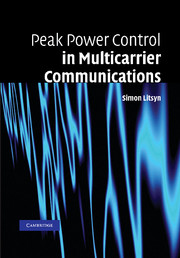Refine search
Actions for selected content:
6778 results in Communications and signal processing

Peak Power Control in Multicarrier Communications
-
- Published online:
- 03 December 2009
- Print publication:
- 04 January 2007
3 - Graphical models of autoregressive processes
-
-
- Book:
- Convex Optimization in Signal Processing and Communications
- Published online:
- 23 February 2011
- Print publication:
- 03 December 2009, pp 89-116
-
- Chapter
- Export citation
1 - Automatic code generation for real-time convex optimization
-
-
- Book:
- Convex Optimization in Signal Processing and Communications
- Published online:
- 23 February 2011
- Print publication:
- 03 December 2009, pp 1-41
-
- Chapter
- Export citation
12 - Nash equilibria: the variational approach
-
-
- Book:
- Convex Optimization in Signal Processing and Communications
- Published online:
- 23 February 2011
- Print publication:
- 03 December 2009, pp 443-493
-
- Chapter
- Export citation
Frontmatter
-
- Book:
- Convex Optimization in Signal Processing and Communications
- Published online:
- 23 February 2011
- Print publication:
- 03 December 2009, pp i-iv
-
- Chapter
- Export citation
2 - Gradient-based algorithms with applications to signal-recovery problems
-
-
- Book:
- Convex Optimization in Signal Processing and Communications
- Published online:
- 23 February 2011
- Print publication:
- 03 December 2009, pp 42-88
-
- Chapter
- Export citation
Preface
-
- Book:
- Convex Optimization in Signal Processing and Communications
- Published online:
- 23 February 2011
- Print publication:
- 03 December 2009, pp xi-xiv
-
- Chapter
- Export citation
7 - Convex analysis for non-negative blind source separation with application in imaging
-
-
- Book:
- Convex Optimization in Signal Processing and Communications
- Published online:
- 23 February 2011
- Print publication:
- 03 December 2009, pp 229-265
-
- Chapter
- Export citation
6 - Semidefinite programming, matrix decomposition, and radar code design
-
-
- Book:
- Convex Optimization in Signal Processing and Communications
- Published online:
- 23 February 2011
- Print publication:
- 03 December 2009, pp 192-228
-
- Chapter
- Export citation
1 - Introduction
-
- Book:
- Modem Theory
- Published online:
- 05 June 2012
- Print publication:
- 26 November 2009, pp 1-30
-
- Chapter
- Export citation
Preface
-
- Book:
- Modem Theory
- Published online:
- 05 June 2012
- Print publication:
- 26 November 2009, pp xii-xiv
-
- Chapter
- Export citation
Frontmatter
-
- Book:
- Modem Theory
- Published online:
- 05 June 2012
- Print publication:
- 26 November 2009, pp i-vi
-
- Chapter
- Export citation
3 - Baseband Demodulation
-
- Book:
- Modem Theory
- Published online:
- 05 June 2012
- Print publication:
- 26 November 2009, pp 58-93
-
- Chapter
- Export citation
12 - Secure Communications
-
- Book:
- Modem Theory
- Published online:
- 05 June 2012
- Print publication:
- 26 November 2009, pp 453-478
-
- Chapter
- Export citation
10 - Codes for Data Transmission
-
- Book:
- Modem Theory
- Published online:
- 05 June 2012
- Print publication:
- 26 November 2009, pp 349-398
-
- Chapter
- Export citation
6 - Passband Demodulation
-
- Book:
- Modem Theory
- Published online:
- 05 June 2012
- Print publication:
- 26 November 2009, pp 176-217
-
- Chapter
- Export citation
9 - Codes for Digital Modulation
-
- Book:
- Modem Theory
- Published online:
- 05 June 2012
- Print publication:
- 26 November 2009, pp 299-348
-
- Chapter
- Export citation
8 - Synchronization
-
- Book:
- Modem Theory
- Published online:
- 05 June 2012
- Print publication:
- 26 November 2009, pp 251-298
-
- Chapter
- Export citation
7 - Principles of Optimal Demodulation
-
- Book:
- Modem Theory
- Published online:
- 05 June 2012
- Print publication:
- 26 November 2009, pp 218-250
-
- Chapter
- Export citation
Index
-
- Book:
- Modem Theory
- Published online:
- 05 June 2012
- Print publication:
- 26 November 2009, pp 488-497
-
- Chapter
- Export citation
